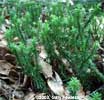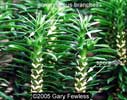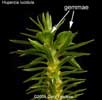
Ferns and Fern Allies of Wisconsin
| Huperzia
lucidula (Michaux) Trevisan shining club-moss Family: Lycopodiaceae |
||||||||||
|
||||||||||
|
The species of Huperzia do not have horizontal stems, as do our other genera in the Lycopodiaceae, and the sporangia are borne at the bases of stem leaves, rather than in terminal strobili as in the other members of Lycopodiaceae. They also tend to have "gemmae" borne on the ends of "gemmiferous branches". The location of the gemmiferous branches is an important distinction later in the key. The gemmae are succulent, vegetative propagules, i.e. if they fall on a suitable location they can generate roots and develop into a new plant, genetically identical to the parent plant. The gemmiferous branches are produced late in the growing season and are therefore restricted to near the end of branches in several of the species (but not H. appalachiana). The gemmae separate from the branches when mature, so you may not find the gemmae late in the year, or on branches formed during previous years, but the gemmiferous branches will persist. Huperzia lucidula is the most common and widespread species in this genus in Wisconsin and it usually grows on soil rather than rocks. Three other species are relatively rare in Wisconsin (all are "special concern") and are restricted to specific localities. These species are H. porophila (growing on rocks, and restricted to the southwestern portion of the state), H. appalachiana (found mostly on rocks and only in Bayfield County near Lake Superior), and H. selago (restricted to the area near Lake Superior on moist or wet rocks or wet soil). Photos will be provided as they become available.
|
|




